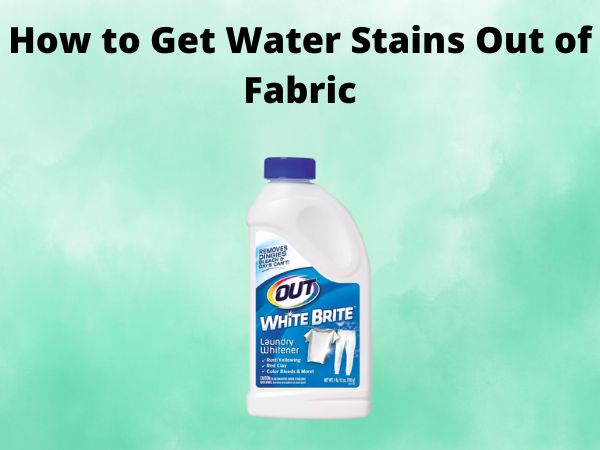How to Get Water Stains Out of Fabric Without Bleach
Have you ever spilled water on your favorite shirt or dress, only to be left with an unsightly stain that just won’t come out? Water stains can be a real pain, especially if you’re trying to avoid using harsh chemicals like bleach. But don’t worry, there are plenty of effective, natural methods for removing those pesky water marks without damaging your fabric. In this comprehensive guide, I’ll share my top tips and tricks for getting your clothes looking fresh and stain-free, no bleach required.
Table of Contents
Understanding Water Stains
Water stains occur when water leaves behind mineral deposits or discoloration on fabric. This can happen for a variety of reasons, such as spills, sweat, or even washing clothes in hard water. While water stains may seem simple, they can actually be quite tricky to remove, especially if they’ve had time to set in.
The key to getting rid of water stains is to act quickly. The longer a stain sits, the harder it will be to remove. That’s why it’s important to treat water stains as soon as possible, before they have a chance to really soak into the fabric.
Natural Stain Removal Methods
Vinegar
One of the most effective natural stain removers is good old-fashioned white vinegar. The acetic acid in vinegar helps to break down and lift water stains from fabric. Simply mix equal parts vinegar and water in a spray bottle, then mist the affected area and let it sit for a few minutes before blotting with a clean cloth. You can also try soaking the stained item in a vinegar solution for an hour or two before washing.
Baking Soda
Baking soda is another fantastic natural cleaning agent that can work wonders on water stains. Make a paste by mixing baking soda and water, then gently rub it into the stain using a soft-bristled brush. Let it sit for 30 minutes to an hour before washing as usual. The abrasive nature of the baking soda will help to lift and remove the stain.
Lemon Juice
The acidic properties of lemon juice make it an excellent stain remover, especially for water marks. Simply squeeze some fresh lemon juice directly onto the stain, let it sit for a few minutes, then blot with a clean cloth. You can also try mixing lemon juice with a bit of water and using it as a pre-treatment before washing.
Salt
Believe it or not, plain old table salt can be a highly effective water stain remover. Make a paste with salt and water, then gently rub it into the stain using a clean cloth or soft-bristled brush. The abrasiveness of the salt will help to lift the stain, while the water helps to dissolve it. Let the paste sit for 30 minutes to an hour before washing.
Hydrogen Peroxide
Hydrogen peroxide is a powerful oxidizing agent that can help to break down and remove water stains. Mix a solution of 1 part hydrogen peroxide to 2 parts water, then apply it to the stain and let it sit for 30 minutes to an hour before washing. Be sure to test the solution on a small, inconspicuous area of the fabric first to ensure it doesn’t cause any discoloration.
Tips for Preventing Water Stains
Of course, the best way to deal with water stains is to prevent them in the first place. Here are a few tips to help keep your fabrics looking their best:
- Treat stains immediately – don’t let them sit and set.
- Wash clothes in cold water to help prevent mineral buildup.
- Use a water softener or filter if you have hard water.
- Avoid over-drying clothes in the dryer, which can set stains.
- Consider using a stain-resistant fabric protector spray.
Conclusion
Water stains may seem like a stubborn and tricky problem, but with the right natural cleaning methods, you can get your fabrics looking fresh and stain-free in no time. From vinegar and baking soda to lemon juice and salt, there are plenty of effective, bleach-free options to try. So the next time you find yourself faced with a pesky water stain, don’t panic – just grab one of these natural remedies and get to work. Your clothes will thank you!
FAQs
Can baking soda and vinegar be used together to remove water stains?
Yes, using a combination of baking soda and vinegar can be an effective way to tackle water stains. The chemical reaction between the two helps to break down and lift the stain. Just make a paste with baking soda and water, apply it to the stain, then spritz with vinegar. Let it sit for a while before washing as usual.
Will heat set a water stain?
Yes, exposing a water stain to heat can cause it to set and become much harder to remove. That’s why it’s important to avoid putting stained items in the dryer, as the high heat can permanently set the stain. Instead, air-dry stained fabrics or use a cool iron setting if needed.
Can water stains be removed from leather?
Removing water stains from leather can be a bit trickier, as the material is more delicate. Your best bet is to blot the stain with a clean, dry cloth as soon as possible. You can also try using a small amount of leather conditioner or saddle soap to gently lift the stain. Avoid using any harsh chemicals or scrubbing, as this can damage the leather.
How do you get water stains out of white clothes?
White fabrics can be particularly tricky when it comes to water stains, as the discoloration really stands out. In addition to the natural methods mentioned earlier, you can also try soaking the item in a diluted bleach solution (1 part bleach to 10 parts water) for a short time before washing. Just be sure to test a small, inconspicuous area first to ensure the bleach doesn’t cause any damage.
Can water stains be removed from upholstery?
Removing water stains from upholstered furniture or fabrics can be a bit more challenging, but it’s certainly possible. Start by blotting the stain with a clean, dry cloth to absorb as much of the moisture as possible. Then, use one of the natural cleaning methods mentioned earlier, such as vinegar or baking soda, and gently work it into the stain. You may need to repeat the process a few times to fully remove the stain.

